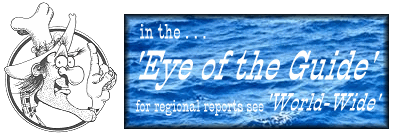The Flies
This series would not be complete without giving
some clue as to the flies Bob and his fishing cronies use.
If you have been reading this series, Bob not only can
'talk the talk' but has photos to prove success.
He had a few that didn't make it back from the photo
lab in time for the previous articles, so those are scattered
through this one. The lovely young lady is Bob's neice
Davya, who shows the results of only second fly fishing
experience. Obviously, she had a great time!

Here are the flies mentioned in Part 1:
Clockwise, beginning at the top: Beadhead
Damsel Nymph, Black Gnat, Gray Hackle Peacock (Dry), Adams, AP Black
Nymph, Elk Hair Caddis, Fur Ant (black), Kings River Caddis and
Tennessee Bee. In the middle, Wooly Worm.

The three flies Bob uses the most are detailed by him below.
King's River Caddis
Hook: Standard dry fly #10-16.
Thread: 6/0 tan or black.
Body: Poly dubbing to match
natural (I tie most in tan or gray, but have also tied these in olive and amber.)
Wing: Mottled turkey (or grouse).
Hackle: Brown (or to match natural)
Dub the body.
Prepare wing by coating with Flex cement. (I usually coat a large
section of turkey feather in advance so that I can tie several at a time.)
Fold wing and attach. Cut at 45 degree angle to achieve the "tent shape" of
a caddis wing.
Attach and add 3-6 wraps of hackle.
I use poly dubbing for all of my dry flies, but
the original pattern calls for racoon. Use what you have!
I think of this a primarily a slow water or still water pattern. However,
it's really become my favorite caddis pattern, period. It is quick to tie
and the fish love it. The only problem with the fly is that it's not real
durable. After even a couple fish, the wing is usually shot. The good news?
The fish don't seem to mind the torn up wing! Keep fishing with it until
you get refusals.
Gray Hackle Peacock
Hook: Standard dry fly - size 10-16.
Thread: 6/0 gray.
Tail: Moose hairs (3-6).
Rib: Copper Krystal Flash.
Body: Peacock herl (about 3 strands).
Hackle: Grizzly.
The name is most often associated with the wet fly pattern. But, the "dry"
version has become one of my favorite attractor patterns.
Tie in tail.
Next, tie in rib and peacock herl. To make the fly
more durable, wrap the herl and rib around the thread several
times and then wrap everything forward as one big rope. (This
will rib the fly at the same time as you create the body.)I really like
using Krystal Flash instead of wire for ribbing on my dry flies because it
is very light weight. Always be aware of the materials you use on a dry fly
and how it effects the flies ability to float!
|




